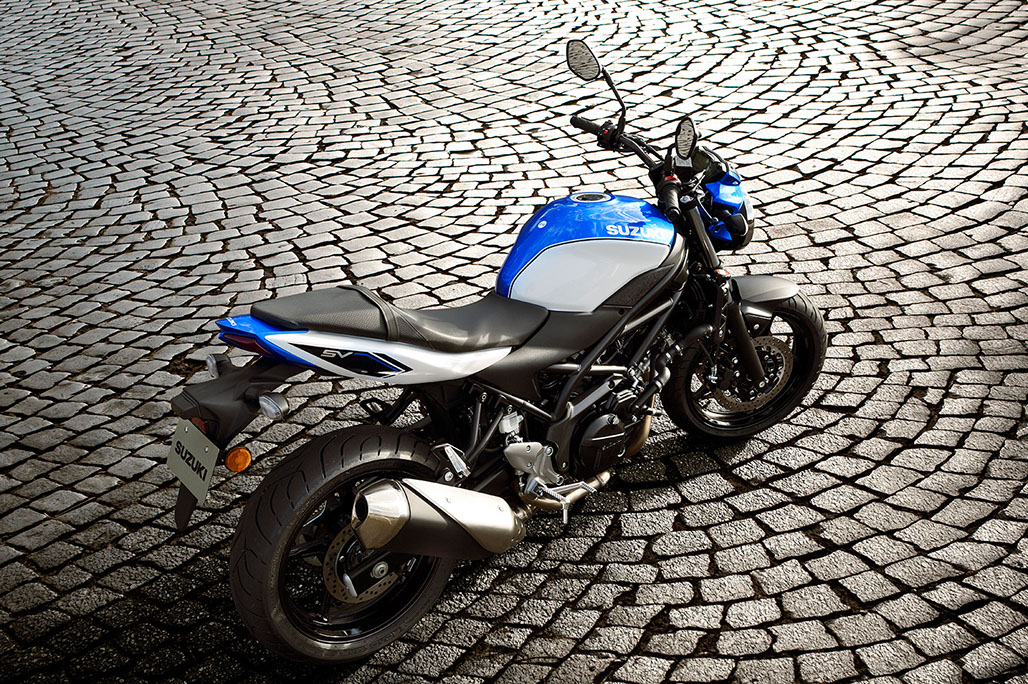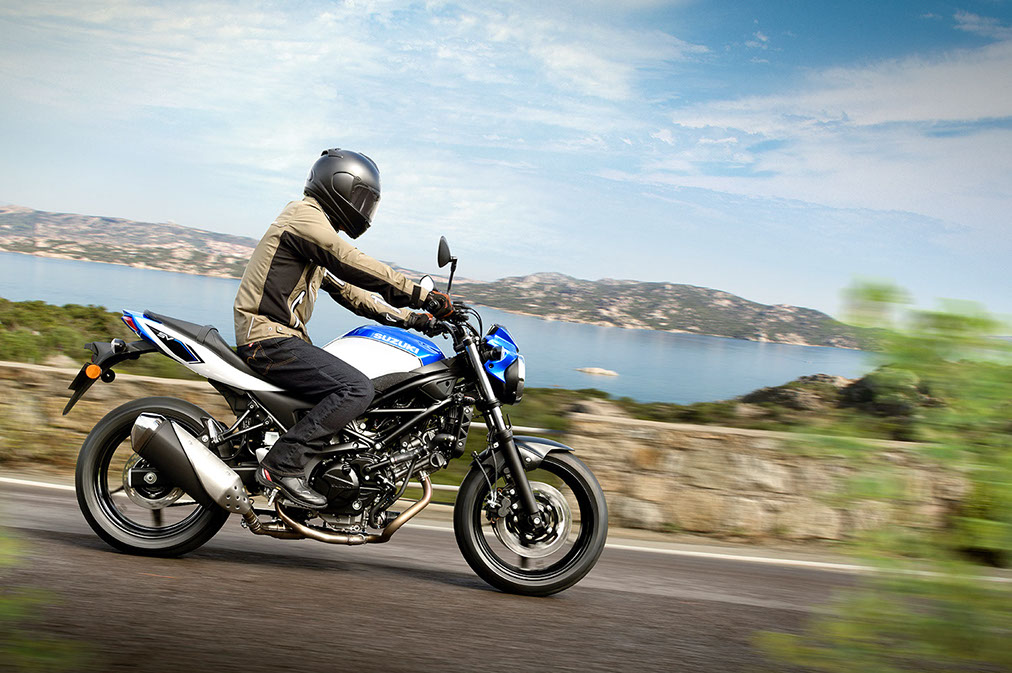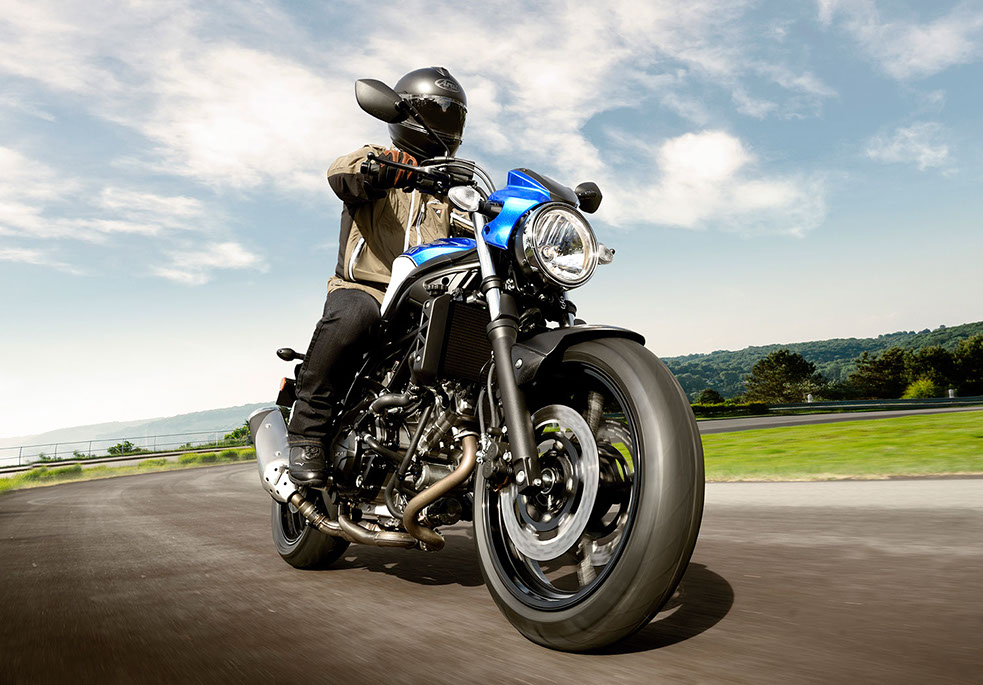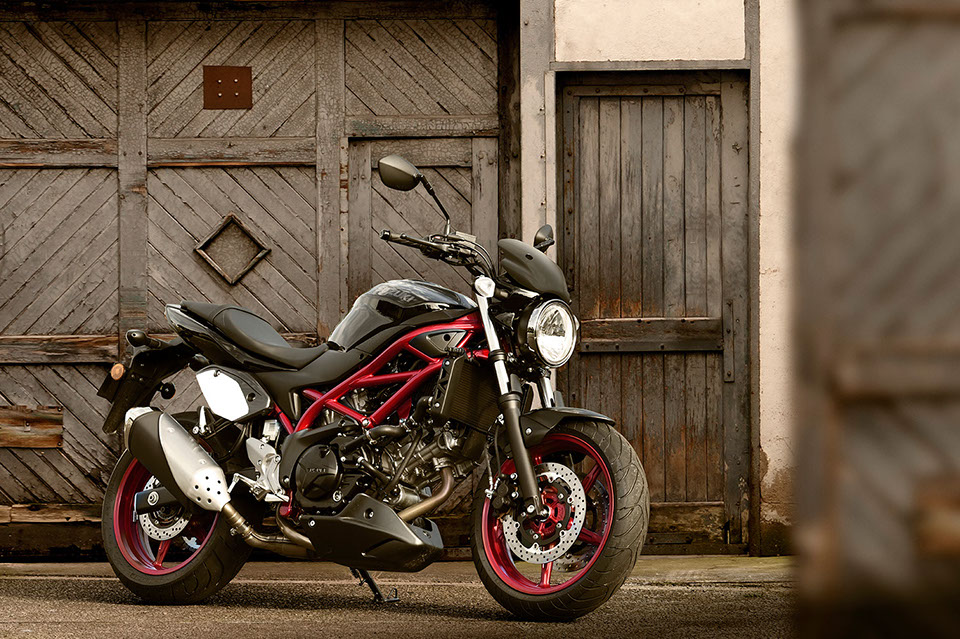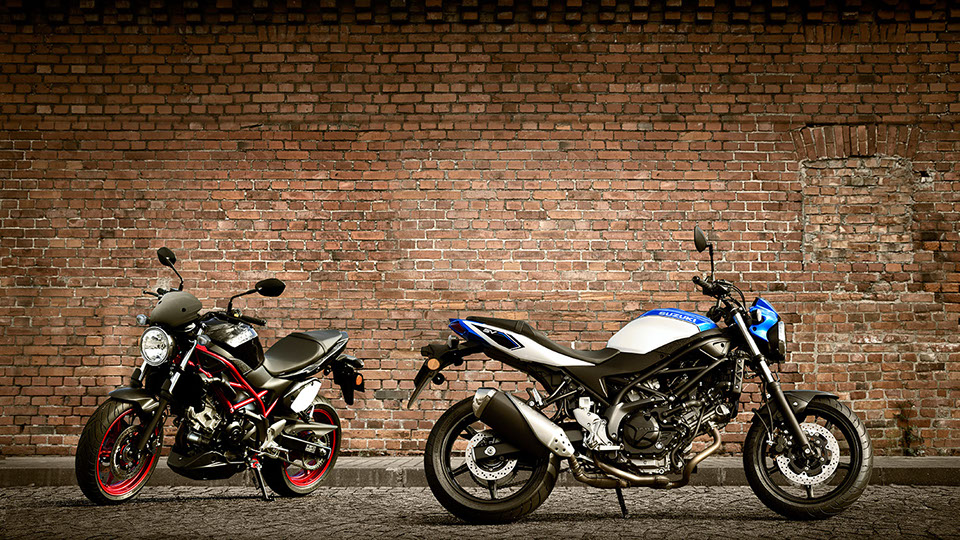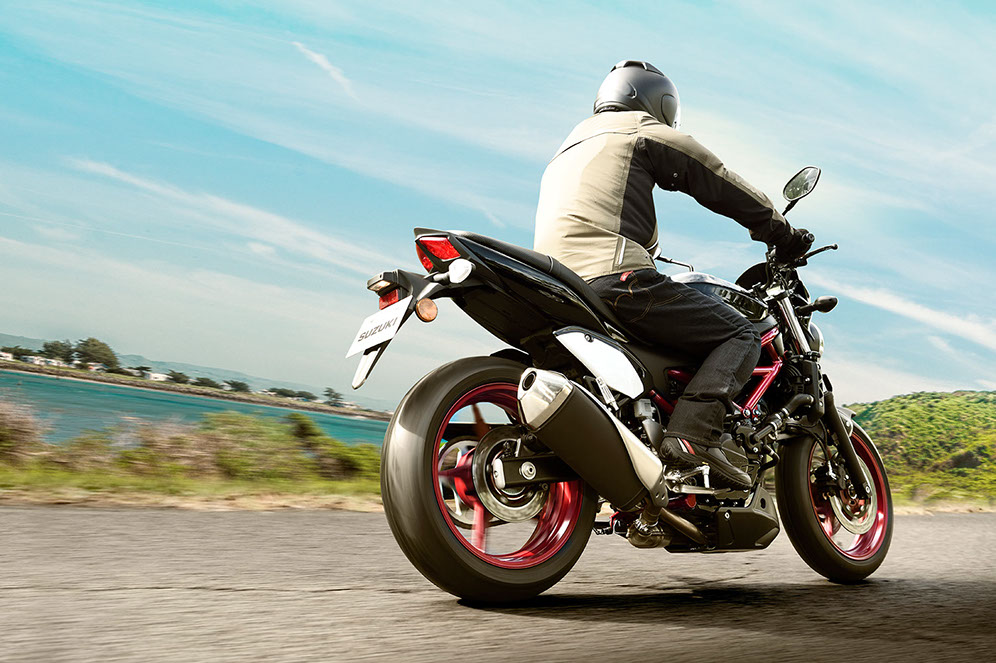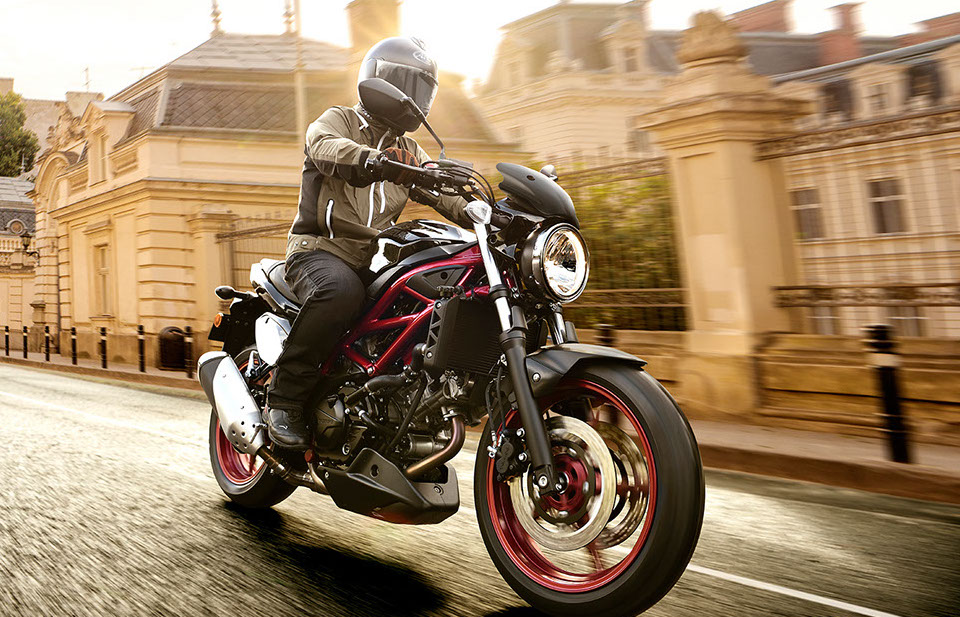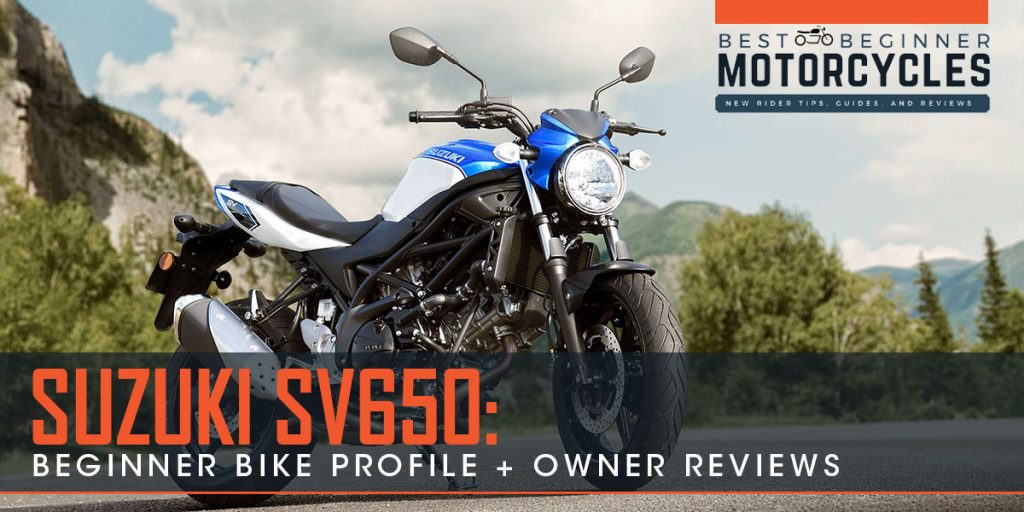The Suzuki SV650 is Not Your Typical Beginner Motorcycle
The SV650 defies the common convention that a beginner rider piloting a bike with 600cc’s or more is setting themselves up for failure. In most cases, the reality is that 600cc’s is simply too much for a new rider.
The Suzuki SV650 respectfully disagrees with that assessment, providing bigger bike riding experience compared to a 500cc or 400cc bike (or even 300cc like the Yamaha R3). Its 645cc v-twin is both powerful and reliable.
As the revs climb, the engine sounds mighty powerful, with low-notes that thrum along as you accelerate. This relatively big and torquey motor makes for excellent all-around performance that gives its rider plenty of jam without being crazy.
It was also the second motorcycle I ever owned, and I have to say that it sure was a treat to ride. Let’s take a deep-dive on the SV650 and why it makes for an excellent beginner motorcycle.
Our Take: Should You Buy a SV650?
The SV650 is at the upper-end of what we’d recommend for beginner riders, but that doesn’t mean that you ought to ignore it. Quite the contrary: if you’re a confident rider, or someone who is learning to ride a motorcycle and wants a beginner bike that will last several years before an upgrade is due, the SV650 is likely the best bike for the task.
It really does exist in a “goldilocks zone”, combining the right amount of power and predictability with ease of use and riding comfort.
Bottom line: the SV650 is that rare combination that gets it all right. Late models come with ABS and an upgraded instrument cluster that aids in nighttime visibility and overall function. This is a great bike.
Reasons to buy the SV650:
- It makes plenty of power
- 1999 – 2002: 64.2 hp / 47.9 kW @ 9,000 rpm
- 2003 – 2014: 73.4 hp / 54.7 kW @ 8,800 rpm
- 2017+: 74.9 hp / 55.9 kW @ 8,500 rpm
- It’s a good height for most people, with an approximate 31″ (800 mm) seat height
- It is a comfortable middleweight, with a wet weight of:
- 1999 – 2002: 417 lb / 189 kg
- 2003 – 2015: 437 lb / 198 kg
- 2017+: 429.9 lbs / 195 kg
- It has a more upright, touring-friendly riding position
- It’s a good looking bike, naked or faired
- It is fuel-efficient, with an average of 48 mpg (per Fuelly)
- A decent example is very affordable, especially when looking at model years under 2014 (under $5,000 for a mint low-mileage bike, under $3,500 for an average bike)
Reasons not to buy the SV650:
- The v-twin engine isn’t quite a smooth as an inline-four
- Its height and weight may be difficult for smaller riders to manipulate
Production Run & Notable Model-Year Changes
Production Run & Model Generations
Suzuki first began manufacturing the SV650 in 1999, with a continuous run from 1999 to the present day.
First Generation (1999 – 2002)
- This was the initial launch o the SV650, and there were no significant changes during these three model years with the exception of…
- Suzuki introduced the SV650S to American and Canadian markets in 2000.
Second Generation (2003 – 2012)
- The 2003 model year featured a new pressure-cast aluminum truss frame, along with revised bodywork, the switch to fuel injection, updated rear brake caliper mounting, and a new LCD instrument panel.
- The 2004 model year featured minor structural changes, including dropping the lower subframe by 40 mm and raising the trail by 2 mm.
- The 2005 model year introduced a smaller radiator (16″ vs. the outgoing 17″ model) and the frame itself was changed from silver to matte black.
- The 2007 model year added dual spark plugs to each cylinder and an optional ABS system.
- The 2008 model year saw the removal of the SV650S from the American market (replaced by the SV650SF)
- The 2009 model year was renamed to the “Gladius”, and a significant structural change was made: the aluminum frame was replaced by a heavier steel frame.
- For many Suzuki enthusiasts, the Gladius was an inferior motorcycle compared to the SV650 and even though the Gladius was renamed (once again) to SV650 in 2013, it wasn’t until 2017 that a “proper” SV650 appeared in Suzuki’s lineup.
Third Generation (2017 – date)
- The 2017 model year saw the reintroduction of a proper SV650, a slight increase in engine power, and the introduction of a low-RPM assist function. The weight was also reduced from 437 to 429 lbs.
Owners Review of the Suzuki SV650
Press & Magazines
2017 Model Year Review
“We really liked the 2017 SV650 and are certainly glad to see the spirit of the original bike return in the latest version. The Suzuki has all the clean styling and spunky personality of the first-gen model but with some new technology added in to put a fine polish on the overall package.”
– Kent Kunitsugu, Cycleworld
2008 Model Year Review
“By offering great performance only matched by handling and comfort, the new Suzi raises the standards and promises to be your companion for miles and miles in or out of town. It is that great!”
– Maxx Biker, TopSpeed
2002 Model Year Review
“How do I sum up the Suzuki SV650? The SV appeals to me for a lot of reasons. It reminds me of the “big” twins I first rode on the street many years ago (remember the Honda CB450, for instance) with its distinctive power pulses and induction sound. It’s light years better, of course, but the simple essence of riding a motorcycle is there — I like that. The SV is light, nimble, easy to ride, predictable and fast. It also looks like a real motorcycle, with its frame and engine contributing to its essential, functional style.”
– Dirk Edge, Motorcycle Daily
What I Like
- ABS – From 2007 onward, the SV650 could be equipped with an ABS system. There’s nothing better for new riders.
- The power – The SV650 runs 0-60 in about 3.2 seconds, and the quarter-mile in 11.85 seconds. For a new rider, that type of performance is more than sufficient.
- The riding position – When I herniated my back in 2010, it promptly removed sportbikes from my lexicon. The upright riding position of the SV650 is both comfortable and practical, and it doesn’t sacrifice sporty performance or the feel of an engaging ride.
What I Don’t Like
- The range – 250 km is about how far you’ll comfortably go on its 3.6 gallon tank.
- No ABS – Not all models come with ABS. Be mindful of this when looking at older bikes.
Review Summary
Suzuki SV650 Competition
If you’re looking at an FZ6, you may also want to check out these other bikes:
[posts count=’3′ tag=’sport-naked’ layout=’block-b-3′ pagination=’infinite’ avoid_duplicate=’true’][/posts]
Suzuki SV650 Specifications
The important specs are listed below. See the Wikipedia page for more detailed specifications.
Dimensions + Chassis
- Height:
- 1999-2002: 44.5 in (1130 mm)
- 2003: 46.3 in (1175 mm)
- 2004 – 2014: 46.1 in (1170 mm)
- 2017+: 42.9 in (1090mm)
- Length:
- 1999-2002: 80.5 in (2045 mm)
- 2003: 83.9 in (2130 mm)
- 2004-2014: 82.1 in (2085 mm)
- 2017+: 84.2 in (2140 mm)
- Ground Clearance:
- 1999-2002: 5.5 in (140 mm)
- 2003: 6.1 in (155 mm)
- 2004-2014: 5.9 in (150 mm)
- 2017+: 5.3 in (135 mm)
- Seat Height:
- 1999-2002: 31.7 in (805 mm)
- 2003 – 2014: 31.5 in (800 mm)
- 2017+: 30.9 in (785 mm)
- Wet Weight:
- 1999 – 2002: 417 lb / 189 kg
- 2003 – 2014: 437 lb / 198 kg
- 2017+: 434.3 lbs / 197 kg (w/ ABS)
Engine
- Engine Type: 4-stroke, 2-cylinder, liquid-cooled, DOHC, 90-degree 645 cc V-Twin
- Maximum Horsepower:
- 1999 – 2002: 64.2 hp @ 9,000 rpm
- 2003 – 2014: 73.4 hp @ 8,8000 rpm
- 2017+: 74.9 hp @ 8,500 rpm
- Maximum Torque:
- 1999 – 2002: 42.3 lb-ft @ 7,200 rpm
- 2003 – 2014: 47.2 lb-ft @ 7,000 rpm
- 2017+: 47 lb-ft @ 8,100 rpm
- Fuel System: Fuel injection
- Fuel Capacity: 16 L (3.5 imp gal; 4.2 US gal)
- Fuel Efficiency: Approximately 48 mpg (4.9 L/100 km)
- Range: Approximately 250 km
Brakes, Rims, & Tires
Note: ABS was optional for model years 2007+.
- Front Brakes: Dual 290 mm floating discs
- Rear Brake: Single 240 mm disc
- Front tire:120/70ZR17M/C (58W), tubeless
- Rear Tire:160/60ZR17M/C (69W), tubeless
Suspension
- Front suspension:
- 1999 – 2002: Kayaba 41 mm telescopic fork, 132 mm (5.2 in) wheel travel. Non-adjustable (1999-2001). Adjustable pre-load (2002).
- 2003 – 2014: 41 mm damping rod fork, 130 mm (5.1 in) travel. Adjustable pre-load.
- 2017+: 41 mm telescopic fork, 125 mm (4.9 in) travel.
- Rear suspension:
- 1999 – 2002: Kayaba single shock, Adjustable pre-load. 127mm (5.0 in) wheel travel. 337mm length. 9.1 kg/mm (510 lb/in) spring rate
- 2003 – 2014: KYB (formally Kayaba) single shock, adjustable pre-load. 330mm bolt-to-bolt length. 7.7 kg/mm (430 lb/in) spring rate.
- 2017+: Link type single shock, 7-step adjustable pre-load, 130 mm (5.1 in) travel

